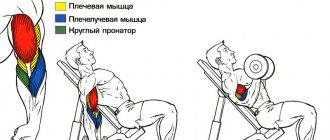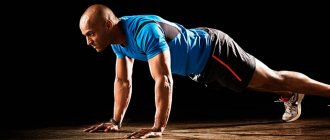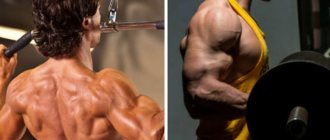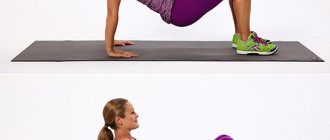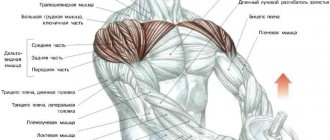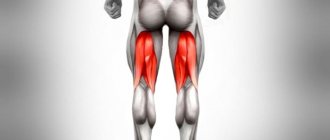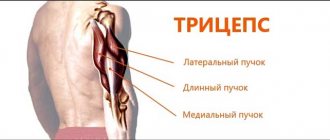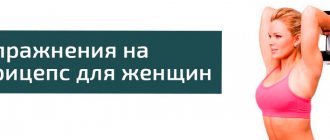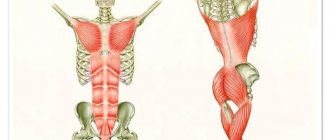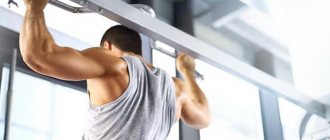Work with dumbbells
Dumbbells are a wonderful sports equipment (how to make dumbbells yourself). Warm up your muscles before exercise (pre-workout warm-up). Avoid jerking movements during exercise.
Proper breathing is also very important. Lifts are done while exhaling, and while inhaling, you need to lower your arms
This way you can train your biceps twice a week. You don't need to do a lot of training. The muscle will not have time to recover and rest. This is dangerous both due to injuries and ineffective training.
If you follow these requirements, you will not get injured and build beautiful muscles.
Effective exercises
Concentrated biceps curl. To perform this you will need a stool. Sit on it, spread your legs slightly to the sides and place your hand with dumbbells between your legs. In this case, the hand should rest in the area of the knee with the elbow on the leg. Just bend and straighten your arm.
When performing this, do not forget the basic rule - supination of the hand when the elbow is bent at a right angle. At the same time, try to tense your biceps as much as possible at the end point. Then pause. Continue to tense the muscle for a count of “one-two-three-four.” Lower your hand in a reverse motion. The same is done with the other hand. Perform the exercise 15-20 times for 3-4 approaches.
Incline lifts on the ball. Take dumbbells with a regular grip (palms facing away from you) and lie with your back on a special sports fitness ball. Use your feet to control your balance so as not to fall to the sides. Start doing dumbbell raises by bending your elbows. Perform the exercise 15-20 times for 3-4 approaches.
When doing this, the forearms receive additional stress.
One-handed lifts on the ball. Kneel in front of the ball. Place one dumbbell hand on the ball. With your other hand, to maintain balance, rest on the ball. No need to tilt your head. Bend the elbow of the hand that holds the dumbbell and, without leaving the ball, lift the dumbbell, doing this only with the help of your biceps. Pause briefly at the top and straighten your arm to the starting position. Perform the exercise 15-20 times for 3-4 approaches.
Bicep curls with a towel. Stand up straight, while holding a dumbbell on a long towel in front of you with straight arms. Look ahead. Inhale and bend your arms while keeping your elbows still. Turn your hands outward as you lift the dumbbell. At the top point, the “neutral” grip should change to an “in-line” grip. Pause before lowering your arms. This will prolong the peak contraction of the biceps. Perform the exercise 15-20 times for 3-4 approaches.
Straight-grip bicep curls or hammer curls. Stand up straight, hold dumbbells with an overhand grip. Slowly bend your arms without changing your grip. At the top point, take a short break. Perform the exercise 15-20 times for 3-4 approaches.
The exercises above are a lot for one workout. It will be enough to choose 2-3 of them that you like best and in which you feel the work of the target muscles best. Sometimes you can alternate or swap them.
A cycle of exercise and proper nutrition will help you build muscle mass. Avoid overexertion, because an overtrained muscle does not grow in volume, but spends energy on recovery.
Execution technique
Biceps exercises should be accompanied by a burning sensation in the last repetitions. Don't carry too much weight. Biceps curls should be smooth. When working with dumbbells or a barbell, the elbows are pressed to the body and fixed at one point. The only moving part of the arm during the exercise is the forearm. After lifting the weight, do not lower it suddenly. The weight should be lowered slowly, allowing the biceps to take on the maximum load in all phases of the movement. You should concentrate your consciousness on the muscle that is involved in the work. It’s the same with biceps – you need to imagine how your arms swell and see how your muscles work.
Arm and shoulder workout
Bodybuilders who have sufficient experience in bodybuilding, as a rule, choose split programs for training. The years spent in the gym affect the results you get. Athletes can no longer fully work out all muscle groups in one or two sessions. To achieve the desired effect, athletes have to devote a specific day of the week to a specific group.
As a rule, no more than two or three groups are involved in one training.
The more muscles are worked during one session, the higher the level of anabolic hormones released.
And if an athlete wants to have developed muscles in the arms and shoulders, then it is best to use joint training for the deltoid muscles and arms, which contains the most effective exercises.
Basic training principles
The classic training scheme has been and remains the most effective. It is based on working first large and then small muscle groups. The program is composed primarily of basic exercises that are performed with an optimal number of repetitions. To gain weight, exercises are done 3 to 4 times, 8-12 repetitions each.
The total duration of one training should be no more than an hour. If you exceed this time “limit”, the level of catabolic hormones will rise sharply and steadily. Between individual exercises take a break of 60-90 seconds, and approaches - from 30 to 40 seconds.
Deltas and arms: training program
The first to work is the shoulder girdle, that is, the front, middle, and rear deltoids, and the second are the biceps and triceps.
The training program consists of ten exercises:
Almost all of the listed exercises in the program are basic. To prevent the muscles from adapting and continuing to increase in volume, it is sometimes necessary to add variety to the exercise. During training, it is recommended to do:
Effective training for shoulders and arms
Working the deltoid muscles, as a rule, also involves the trapezius muscles. Therefore, they also require close attention. To work your trapezius, you should perform shrugs with weights such as dumbbells. It is necessary to constantly monitor your own progress.
When it slows down or a raft state sets in, it’s time to start high-volume methods that involve training in a system of drop sets, forced repetitions, and supersets.
This step will allow you not to stop muscle growth and continue to progress.
Joint training of deltoids and arms: a set of exercises
When combining the muscles of the shoulder girdle and arms within one lesson, the deltoids are trained first, followed by the biceps and triceps. The first exercise plan is usually the military press, which focuses the load on the middle and front deltoids. In addition to the deltas, this exercise also actively works the triceps muscles of the shoulder. The military press is followed by a seated dumbbell press, which targets all three bundles of the target muscle. By pulling the barbell to your chin with a wide grip, you can pump up the middle and rear deltoids. Bent over swings help to “finish off” the back beams, and side lifts of dumbbells help the middle ones.
The biceps brachii muscle can be pumped up by doing close-grip pull-ups on the bar. Another effective biceps exercise is lifting a barbell in front of you (arm curl). Hammer curls can be used as an auxiliary exercise. The narrow bench press and French press are ideal choices for developing triceps.
Each movement from this set of exercises must be repeated 8-12 times (pull-ups to the bar 8-10 times). A series of 8-12 repetitions constitutes one set. There should be 3-4 such sets in total. Rest between sets lasts 30-40 seconds. Since muscles tend to adapt to the same type of impact over time, the proposed set of exercises must be periodically updated and adjusted.
Basics
For girls and guys who want to pump up their arms, it is important to understand that the best exercises are the basic ones. Many people try to include isolation movements in the program, but this is a serious mistake that can lead to injuries and other unpleasant consequences.
If you are new to strength training and bodybuilding, isolated exercises are contraindicated for you.
Basic exercises that target the triceps include the following:
Push ups. This is a universal and at the same time the most effective basic exercise that allows you to work the entire upper shoulder girdle. There are many variations of doing push-ups - from the floor, on parallel bars, on a bench, on a horizontal bar
It is important to choose a comfortable rhythm and place your hands with a medium grip. Bench press
The exercise is performed with a barbell; you can use a Smith machine. You need to lie down on a bench, with your feet on the floor, take the barbell from the support with a straight grip, and place it at chest level with straight arms. As you inhale, lower the barbell towards your body, lightly touching it, and raise your arms up again. At the maximum point, fix the position for a couple of seconds and repeat the movement.
These two training options are among the TOP exercises that allow you to influence the external and internal bundle of muscles of the arm
Before performing it, it is important to warm up, stretch your joints and muscles. When working with a barbell, it is necessary for someone to insure the athlete
Basic muscle exercises.
Basic exercises for biceps, triceps, shoulders, chest, back, legs in pictures. To perform a basic biceps exercise, pick up a barbell with a short bar. Why short? Because with it you won’t have to waste extra energy maintaining balance. The bar must be straight. It is a wide grip, as opposed to a narrow one, that allows you to load the most important internal bundle of the biceps. You need to perform biceps exercises in three sets of 10-12 repetitions.
Take a deep breath and hold your breath. Using an isolated effort of the biceps muscles, slowly lift the barbell up. At the same time, keep your elbows motionless. When the bar reaches the end point (shoulders), make an accented pause and also slowly lower your arms to the starting position.
When performing barbell curls, try not to overload the barbell with excess weight. If you have to jerk the barbell to perform the exercise, then reduce the weight. At the end of the last set, you can do this: after “refusing”, move your elbows back and finish the set with several repetitions in this position.
Biceps exercise with a curved barbell. Biceps curl with a curved barbell - this exercise allows you to reduce the high and dangerous load on the wrist.
This exercise helps reduce excessive inward rotation of the wrist, which causes pain. The rest of the exercise is performed similarly to straight barbell curls.
Basic chest exercise: barbell chest press, lying on a horizontal bench.
The bench press from the chest is one of the most popular exercises in the gym, this is due to the technical simplicity of the exercise and the rapid progress in this movement, provided that the correct technique is followed.
The illustration above shows a diagram of how to perform a bench press and shows which muscles are involved in the work.
Bench press lying on an incline bench 40
Bench press on an inclined bench 40 degrees - this exercise loads the clavicular part of the pectoralis major muscle, the anterior parts of the deltoid muscles; triceps, serratus anterior and pectoralis minor muscles.
Basic shoulder exercise: barbell chest press.
The chest press is the most basic exercise that most specifically targets the anterior and middle deltoids, clavicular pectoralis, upper trapezius, triceps, serratus anterior, and deep supraspinatus. The chest press can be performed as in a sitting position and in a standing position. When performing this exercise in a standing position, you should not arch your lower back too much. To increase the load on the front deltoid muscles of the shoulder, bring your elbows slightly forward. For a more intense effect on the middle sections of the deltoid muscles, it is better to move your elbows apart (spread to the sides).
Basic exercise for the back: rowing a barbell while standing on an incline.
Bent-over barbell row - the exercise engages the latissimus dorsi, teres major, posterior deltoids, arm flexors (biceps, brachialis, brachioradialis) and, when bringing the shoulder blades together, the rhomboid and trapezius muscles. Additionally, the movement involves the spinal extensors in isometric tension. You can focus the load on different areas of the back by changing the grip width, as well as the degree of torso tilt.
Basic triceps exercise: bench press.
One of the most effective exercises for triceps, well developing all its parts.
Basic leg exercise: squats with a barbell on your shoulders.
Squat exercises with a barbell on the shoulders are performed in a standing position. The bar is placed on a special rack. Take the bar with your hands at a width that is comfortable for your body type. Sit under the bar, placing it on the trapezius muscles slightly above the back of the deltoids, and move your elbows back.
We train the back and biceps - exercises for one and for different days
Training your back and biceps in one day is a classic version of training that instructors in fitness rooms offer us today. Let's see if this is correct and what exercises are included in this program.
On the same day or on different days?
It turns out that many back exercises involve the biceps, but not vice versa! That is, by pumping your back, you can also pump your biceps, but when working the biceps muscle, you will not use the back muscles.
On the subject: How to pump up broad shoulders at home
There are some back exercises that do not involve the biceps muscle at all or only slightly affect it. This is, for example: bent over dumbbell raises (loads the trapezius and shoulders), hyperextension, etc.
Pull-ups, bent-over dumbbell rows, block rows, barbell rows and any other exercises where you lift weights by bending your arms involve the biceps.
Therefore, if you decide to pump them in one day, start with the heavier one - from the back.
Advice!
It is difficult to talk about the correctness of this approach in training the back and biceps. This is practiced everywhere. And everyone chooses for himself whether such a scheme is acceptable specifically for him.
You need to focus on the following: if you started working on your biceps and feel that you don’t have enough strength to complete the exercise, it’s too early for you to train your back and biceps on the same day.
It is better for beginners to adhere to just this scheme, since when training with the back on the same day, the effectiveness of biceps training decreases. The muscles already get tired during back exercises. And there is no longer enough strength to fully work with your hands.
You can cheat and do the biceps lift first, and then pump up your back. But this contradicts the training policy in the gym, which says: first train large muscles, then small ones. That is why, at the beginning of any training, basic exercises are done, and then some isolated ones.
Therefore, at the beginning of the training, the legs and back are pumped, and then everything else. This makes sense from the point of view of energy consumption - a large muscle consumes more energy than a small one. Therefore, it is not recommended to pump your biceps in front of your back.
As a result, we can say:
- When it comes to fat-burning training, it makes no difference whether you combine or separate the training of these muscle groups. Since you are not trying to increase strength and muscle size.
- In the case of bodybuilding, it is permissible to work in a one-day mode.
- In strength training, it is more effective to give the muscles normal rest.
Back and biceps exercises in one day
If you decide to train both muscle groups on the same day, here is a list of exercises that you can use.
Back
First we do exercises for the back.
Wide-grip pull-ups or bent-over rows
On the day of training the back and biceps, it is not advisable to do a lot of pull-ups with a narrow grip, since the emphasis of the load falls on the arms.
Since you are pumping your back, let’s pump it up, that is, pull yourself up with a wide grip behind your head. You can divide the exercise into 2 parts: 2 approaches you pull yourself up by your head, and 2 approaches you pull the horizontal bar to your chest. In any case, remember that you still have to pump your biceps.
Other rows, fly-ups, hyperextensions
Instead of a horizontal bar, you can work in a block simulator using the same scheme.
- Next comes either the T-bar row, or the row in the simulator, or the lower block row to the lower back. Do this exercise in 3 sets of 8-10 times.
- Then take dumbbells and do bent-over raises on the upper back and back of the deltoids. Or raising your arms in a block simulator.
- And don’t forget to do hyperextension to keep your lower back toned. It should be done twice a week - on back day and before deadlifts as a warm-up for the lower back.
This is an approximate scheme; each person individually needs to select a training program, check it, and constantly adjust it. Therefore, it is still better to order it from an experienced trainer rather than experimenting yourself.
Biceps
Next, we will have hands.
Barbell Curl
For biceps, the basic exercise is the barbell curl. If you've already done an upper back workout, do 3 sets of this exercise with enough weight to complete 8-10 reps.
It is advisable to lean your back against a wall or a power frame. Secure your elbows to the body and work without throwing the barbell upward due to vibrations of the torso. It's the hands that have to do the work.
Scott's bench
This is an alternative to the concentrated biceps curl, but this exercise is slightly different from the curl. Therefore, you can perform either this or the version with dumbbells.
Choose the weight carefully: the exercise is easy during the first repetitions, but then it makes you sweat. If you keep your arms straight, this exercise will be easier.
Attention!
But the whole point is the maximum amplitude of muscle contraction. Therefore, on the Scott bench you need to work at full amplitude.
It is recommended to work in the upper zone of amplitude after stretching the biceps with light weights three times a week (in the absence of acute pain).
Dumbbell Curl
Instead of a Scott bench, you can use dumbbells on an incline bench.
Alternatively, you can sit on a Scott bench, but with your back to the elbow pad. Lower yourself down a little so that your arms hang back a little under the force of gravity. From this position it is convenient to do biceps curls in different styles - with a parallel grip and in the form of a “hammer”.
Focus on the exercise, you must understand and feel what you are doing, and not just mechanically practice the movements. Such conscious control will help to clearly maintain the exercise technique.
Biceps exercises on a separate day
When your biceps are not tired from back exercises, you can do more arm exercises.
For example:
- Curling arms with a barbell.
- Hammer.
- Concentrated biceps curl.
Instead of a hammer, you should periodically do dumbbell curls. For example, one week you do a hammer, and the next week you do a regular curl. Some people say that turning your palm during dumbbell curls is harmful. But many athletes do it and achieve excellent results. It's up to you what to choose.
Since your biceps are not yet exhausted, you can do all the exercises in 4 sets. Work to failure in everything except fat loss. In the latter option, your task is to do many repetitions in a short time.
Hammer and dumbbell curls can be done with both hands at the same time or alternately. In the latter case, you cannot raise the second hand until the first one stops. There are explanations for this, just remember this nuance.
Strength fitness basic training rules
Arm training follows the standard rules of strength training: first, large muscle masses are worked out, then attention is focused on individual muscles. The training plan consists mainly of basic exercises
Each of them involves several muscle groups at the same time. “Base” effectively grows muscle mass and increases strength. To successfully build muscle mass, you need to perform 3-4 sets of each exercise, 8-12 reps per set.
The rules of strength fitness strictly regulate not only the choice of exercises, but also the duration of training. It is generally not recommended to exercise for more than 1 hour. With intense power loads, the level of catabolic hormones in the blood gradually increases, and decay processes begin to predominate in the muscles. You need to rest no longer than 90 seconds between exercises, and 30-40 seconds between individual sets.
Tips for correct and more effective exercise technique
Now let's figure out how to pump up your arms in the gym, using special techniques in each movement with an emphasis on the relief and mass of the biceps and triceps muscles. If we pump any muscle group with the wrong technique, the effectiveness of the exercise decreases and the risk of injury increases. And in some cases, a different muscle group and not the target muscle group is pumped. For example, in biceps curls, the back can be involved if the technique is incorrect, especially when cheating.
There must be a mental connection between brain and muscle, that is, you must feel the work of the target group.
Seated dumbbell curls and French bench press with dumbbells
Start with 4 sets of dumbbell curls. Perform each repetition at a slow pace, with an emphasis on the negative phase. During the concentric phase of the movement, rotate the hand so that the little finger is on top at the end point.
For the last set, halve the weight. While you perform eight repetitions with one arm, keep the other in a contracted position. Then change hands and repeat. Immediately do 7 reps with one arm while keeping the other contracted, then switch arms and do 7 more. Continue shortening the reps until there is only one rep left. Do it with each hand to complete the exercise.
Follow the same plan for the French bench press. Hold the dumbbell at the bottom of the amplitude, maintaining tension in the triceps.
Bicep curls on a Scott bench and seated French press with a dumbbell
When performing curls on a Scott bench, do not lift the barbell all the way to avoid losing tension in the muscle. Do not delay the movement so that the biceps constantly contracts. In extensions from behind the head, the elbows look up and do not move apart. Lower the dumbbell to the very bottom, properly stretching the triceps. As with curls, don't stop at the top. Move constantly, keeping tension in your biceps and triceps all the time.
For the final set, use a double drop set for both exercises. In it you go to failure. You won't be able to do as many reps as you did when you started, but get at least 6.
Bicep curls on an incline bench and overhead arm extensions on a block with a rope handle
Lower your hands to the very bottom for a good stretch of the biceps. At the bottom, squeeze your triceps to give your biceps a maximum stretch. After completing the twelfth repetition of the fourth set, lower your arms again and hold them for 30 seconds to stretch. Lose the weight by 4-5 kg, perform the exercise to failure, and lower the dumbbells again for a 30-second stretch. Lose the weight again by 4-5 kg, perform to failure and repeat the stretch.
In extensions, pull the rope as far back as possible to fully stretch the triceps. After the twelfth repetition of the fourth set, repeat the drop sets exactly as in the previous exercise.
If you were able to complete 10 or more reps before failure on any of your finishing sets, add more weight next time.
Barbell curls and arm extensions on an overhead block with a rope handle
Perform the first seven reps standing, lifting the barbell from your hips to a right angle at the elbow, then immediately sit down for the next seven reps. In a sitting position, you will not be able to lower the bar below your hips. Once completed, stand back up and do the remaining seven full range of motion, moving the barbell from your chest to your hips, bringing the total number of reps to 21.
Here all repetitions are performed standing. The first seven repetitions start from the waist and reach the hips. The next seven starts from the shoulders and finishes at waist level. The final seven is a full range of motion, from the shoulders to the hips. Total 21 repetitions. Try to keep the ends of the rope as far apart as possible.
Alternating hammer curls and extensions on a block with one hand
Bend your arms alternately for a more powerful movement. When doing extensions, additionally contract your triceps, and at the bottom point, tense your entire arm for half a second.
Lower pulley biceps curl with cable handle and pulley extension with straight handle
There is no better way to finish this arm workout than by wearing BFR bands. You will achieve a great pump and pump blood and nutrients into your arms.
Place the BFR bands high on your biceps. Tighten them 6-7 points on a scale of ten. Maintain them for all 5 sets. When performing exercises, rest 45 seconds between sets to achieve an extreme pump.
We recommend doing this workout once every two weeks. There's just too much volume and it's just too damn hard to do every week.
If you do these 5 exercises, you will have powerful biceps
Guys love to pump up their biceps because they can see their big arms from afar, unlike their legs, which are hidden in their pants. True, pumping up this biggest arm is problematic due to four banal reasons :
- too much strain on the arm muscles;
- too little load;
- emphasis on the biceps alone without working on the triceps;
- lack of muscle relief.
I'll start from the end. Even if the arm has a girth of 50+ cm, but it looks like a fat stick of boiled sausage, there will be no such effect as from dry, sculpted biceps, even if its volume is 3-7 cm less. If you want to achieve a cool effect, dry it off.
Also remember that the biceps only makes up one third of the arm. Another two-thirds are triceps. A truly massive limb can be made only by actively training both mentioned muscle groups.
As for the load, there is both the problem of lame exercise technique and a lack of understanding of the fact that the arms are well loaded in all pulling and pressing movements.
Attention!
A person trains his biceps this way and that, with different grips, with different hand widths, with a barbell and with dumbbells, with and without emphasis on the elbows, but the bastard doesn’t grow. But if you watch such a person from the side, you see how he bends his whole body, throwing an overly heavy barbell upward when lifting his biceps and dropping it back.
It’s the same with dumbbells - a jerk with the whole body, the projectile flies up by inertia, then they just drop it back and where is the work of the biceps? She doesn't exist. This is called “pumping up your ego”, but seriously, it’s a banal lack of technique for performing the exercise.
The selection of exercises within the microcycle matters
There are times when everything is ok with the technique, but by dedicating a separate workout to the arms, or even training the biceps and triceps separately, a person simply overloads these small muscles.
Let’s say he trained his back and chest in one workout, and the next day he trains his arms.
But they have already worked well in all pulling and pushing exercises, especially if a person has reached significant working weights comparable to his own body weight. This is an unwise design of a microcycle.
It makes sense to either insert a leg day between training your back, chest and arms, or change the exercises in the split. For example, after training the pectorals, add 1-2 triceps exercises to finish it off after working on bench press exercises.
Similarly with back training, during which the biceps work well. 1-2 exercises are enough to knock him down well in the end.
That is, the program is compiled with an emphasis on the work of assistant muscles (the triceps also work in the bench press, and the biceps in the pull-down to the abdomen and chest).
The second option for breaking down workouts is to focus on muscle groups that are not related to each other in order to work them out to the maximum. Again, we take a large muscle group and a small one.
In our case, this will be a separate training for the pectoral and biceps (first the pectoral 2-4 exercises, since it is a larger and more energy-consuming group, then the biceps - a couple of exercises) and a separate training for the back and triceps.
Deltas can be trained together with the legs.
What's better? To each his own, try different options, spending at least 6-8 weeks on each training program to come to a conclusion.
I personally prefer to load the muscles independently, which actually allows me to train my arms a couple of times a week, subject to 3 training sessions in a microcycle.
Important!
During the back workout, the biceps worked as an assistant, and then I also pumped them up thoroughly along with the pecs on a separate day. Same with the triceps.
Let me remind you that to effectively specialize in a particular muscle group, you need to train it at least twice a week, as I mentioned in this article.
Well, we've sorted out load cycling, now let's move on directly to the most effective exercises.
Five Powerful Exercises to Build Bazooka Arms
Below are the most effective exercises for training hands, in the author’s opinion, but this is not the ultimate truth. Each has its own levers, muscle attachments and dominant groups, respectively, what works well on one is not a fact that it will work on another. But there is also such a thing as anatomy and biomechanics of movements, research and experience. Based on all this, I selected the exercises.
On the subject: How to pump up the oblique abdominal muscles
So, the biceps has only two attachment points and in any case is fully involved in traction movements and when bending the arms. Accordingly, the width of the grip does not matter. Just choose the one that is convenient for you, as well as the neck option - EZ or classic straight. The only exception is the position of the “Hammer” type brushes. In this case, brachialis is already working.
Accordingly, why invent a bicycle when the good old fashioned way is enough to effectively develop your hands...
...Bicep Curls
This is a classic. For beginners, when working in FullBody mode, only this exercise will be enough for 3-4 months to train a bitsuha. I described the main nuances above, and you can see them in the video below:
Lifting dumbbells for biceps while sitting on an inclined bench
Another very effective exercise for training your biceps. Moreover, according to my observations, it loads the biceps muscle of the arm more efficiently than the classic standing dumbbell lift with supination. In principle, a couple of these exercises are enough for high-quality biceps development.
But there is one more basic exercise that is considered the most effective. This…
...Reverse grip biceps pull-ups
Involves several joints at once, unlike the movements described above (only the elbow joint works).
There are a minimum of features here - use a narrow reverse grip and try to ensure that the main movement is in the elbow joint, excluding the back muscles.
Advice!
Sometimes you can do pull-ups with a narrow straight grip to develop the brachialis muscle, which is located under the biceps and when it is developed, it seems to push out the biceps, making it more impressive.
As an additional alternative exercise, I can recommend barbell curls at Scott's shop. Options for working in a block are essentially similar to those with a barbell or dumbbells.
Let's move on to the triceps. In the past, I did a bunch of different extensions in blocks with different handles and grips, with dumbbells and so on, but only two exercises turned out to be the most effective for developing the triceps muscles of the arms. First…
... Bench press with a narrow grip
A basic exercise that involves all three heads of the triceps. I will highlight the following important features:
- grip width - at shoulder level or slightly wider, so that the hands do not bend inward;
- the location of the bar is at the base of the palm;
- the trajectory of movement is to the lower part of the chest and there is no need to lower the bar until it touches; as soon as the arms are level with the body, we lift the projectile back, not bringing it 10-15 cm down.
- Elbows parallel to the body, in the upper position we fully extend our arms.
French press
A slightly more isolated movement, in which it is important to fix your elbows in one position and not spread them to the sides.
If the exercise is not suitable for you (I have come across this in practice - some people cannot fix their elbows without spreading them to the sides, or they feel acute pain), you can replace them with arm extensions in a block:
Secret Secrets
The main secret to effective training of the arms, and any other parts of the body, is a systematic increase in load from training to training. Read more about this in this article:
- How to choose a weight to progress without injury
The second secret is if you want big arms, train your legs. At least when it comes to natural training. Legs are the largest muscle group, the training of which produces the greatest release of anabolic hormones, which in turn has a positive effect on the growth of all muscles, including the arms. Research on the topic is described here.
Source: https://www.iphones.ru/iNotes/editorial-biceps-workout
Program for biceps and triceps
The program lasts 14 weeks. For the first 3 weeks, you should focus on no more than three exercises for each muscle group. The program should consist of 6-8 sets for biceps and 8-10 for triceps.
From weeks 4 to 9 the largest volume of training occurs. After the first weeks, the body begins to adapt to the stress, so it is necessary to increase the intensity. The biceps and triceps in the video will look great after such exercises. You should also stick to two or three exercises, but add additional weight and number of approaches.
From weeks 10 to 12, the volume of training decreases again. The number of approaches is even less than in the first weeks when using 2 exercises. The volume will be reduced due to fewer approaches, but it is at this time that you will get a colossal effect from them.
From 13 to 14 weeks - the rest phase. It is necessary in any program. By skipping some time from training, you will not only be freed from constant physical fatigue, it will also be beneficial for your mental state.
Recommendations for training triceps
A few basic recommendations for performing triceps exercises:
Choose the right working weight and determine the range of repetitions. For massive triceps, combine both strength work (8-12 reps) and pumping (15-20 reps) in your training schedule. But remember that the exercise will not be effective if you do not feel the muscles working. You should feel your triceps contracting and stretching with each repetition.
Gradually increase the weight of the additional weight when doing dips. This is one of the most traumatic exercises for the elbow joints.
It is better to place this exercise closer to the final part of the workout and work with a relatively light weight.
When performing French presses, it is fundamentally important to concentrate on stretching the triceps during the negative phase of the movement (during the descent). It should be 2 or even 3 times longer than lifting the projectile up
The whole benefit of this exercise lies precisely in this. In other movements you will not be able to stretch the medial head as much. Although the emphasis should be on the negative phase in all exercises for this muscle group.
Minimize cheating (swinging of the body) when performing arm extensions on the upper block. Rocking deprives this exercise of any meaning and removes all the stress from the triceps brachii muscle.
Use all available ways to increase the intensity of your training. The triceps are a relatively small muscle group: if you want to see noticeable progress, you need to hit it hard. Doing partial reps after reaching failure, asking a partner to help you do a couple extra reps, finishing off with light weights after each heavy set are all great for the triceps. But don't overdo it. This muscle also works actively during chest and deltoids training. Doing too many triceps exercises can ultimately lead to overtraining and lack of growth.
Make the most of your rest time between sets by stretching your triceps. The more flexible your muscles are, the more comfortable you will be in performing exercises through a full range of motion. It will also improve pumping and neuromuscular communication, stretch the fascia and reduce the likelihood of injury.
Experiment with your split program. Triceps can be trained together with the chest, back, shoulders or biceps. Choose the option that suits you best, or alternate variations monthly.
Breaks between approaches should not exceed 1-1.5 minutes. This way, the flow of blood into the working muscles will be maximum, and the muscles will not have time to cool down after intense exercise. Perhaps the only exception is the close-grip heavy bench press, where more rest is allowed for recovery.
If you train your arms on a separate day, work in supersets - work your triceps first, and then move on to your biceps. The triceps is a larger, stronger muscle that requires more heavy loads to grow. Therefore, it is advisable to first load it while you are full of energy. In addition, while you do the biceps, the triceps will rest, which can reduce your rest time.
